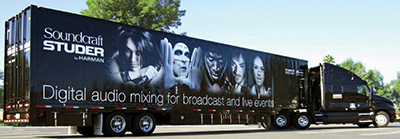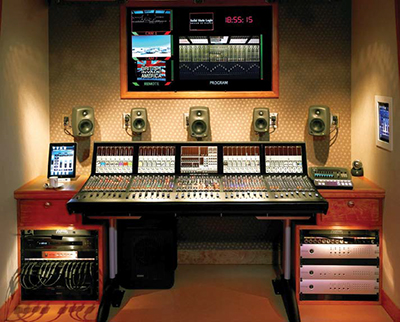Learning the Console Ropes

Studer has deployed a 75-foot mobile studio to demonstrate its latest products.
LOS ANGELES—While ubiquitous internet connectivity has put technical information and educational resources at everybody’s fingertips, when shopping for a broadcast audio mixing console there is often no substitute for taking a test drive.
“We don’t believe that you can really purchase an audio console without seeing it and touching it,” said Frank Grundstein, director of sales for Logitek in Houston. “People tend to route audio very idiosyncratically, even within the same station, so we’ll bring out a console and let the morning news crew see it, then the afternoon news crew. We find that acceptance of the console increases significantly if they’ve touched it beforehand.”
Education is central to the sales process with any broadcast mixing console, according to Phil Owens, who handles eastern U.S. sales for Wheatstone Corp. “The overall model of a TV board has changed so drastically over the past five years or so. You have to do a fair amount of education just to get people up to speed with the whole concept that this is a router, not an audio board. Our system, like 90 percent of all the others out there, has a router that is the basis of the audio network that the control surface can draw upon to create its mixes.”
ON THE ROAD
The broadcast sales cycle can be lengthy, offering plenty of opportunities for the engineering staff and board operators to educate themselves on the intended console. But how they get their hands on a desk can vary. Solid State Logic currently has a broadcast demonstration vehicle entering its second year touring the United States. Training and education were the most important factors in building it and sending it out on the road, said to Dan Duffell, head of marketing for the U.K.-based company.
The truck’s schedule is driven by requests from potential clients as well as proactive sales initiatives, Duffell said. “It rolls into TV stations, it turns up at [Society of Broadcast Engineer] and [Audio Engineering Society] chapter meetings, and anywhere that it can find an interested audience.”

The SSL Broadcast Equipment Demonstration Vehicle is a custom designed mobile unit which replicates a fully operational on-air audio production suite. The vehicle is equipped with the SSL C10 HD compact digital audio console, a MORSE Router and SSL’s Broadcast I/O. Studer, too, has a mobile demo unit. “We use a 73-foot truck that we drive around,” said Katy Templeman-Holmes of U.S. marketing for Soundcraft Studer.
Companies sometimes ship in a complete console, or a smaller, demo version, Wheatstone’s Owens said. “We’ve gotten pretty good at providing self-contained demo systems that we can easily ship,”he said. “Normally—I would say 75 percent of the time—we will do a site visit with a demo system prior to the sale.”
Logitek has done many, many SBE presentations over the years, Grundstein said.“The smaller consoles, which are being purchased more and more by smaller markets— particularly those with automation systems—those we bring around,” he said.
Downloadable technical resources— wiring diagrams, quick start guides, operator manuals, software, white papers, and the like—can help clients configure the console and plan its integration into the plant, according to Owens.
“Probably the most effective are the technical manuals,” he said. During the planning phase, “you’re drawing up lists of I/Os, how they want the I/O distributed around the plant, configuring the router, choosing the correct control surface so that they have the feature set that they want for their board operators. Really that’s where our education process starts.”
FREELANCE AND FULL-TIME
U.K.-based Calrec stepped up its educational efforts in 2013 with a series of training sessions run by Dave Lewty, U.S. regional sales manager. The program, offering operational training on Calrec’s Bluefin2 range of consoles, is aimed at freelancers as well as facility employees.
“This program is part of a larger educational drive we have been promoting over the past few years, which also prompted the creation of our popular Audio Primer and Network Primer,” Lewty said. The two primers, originally a series of posts on Calrec’s online community board, have been adopted worldwide by further education establishments, other manufacturers, and industry bodies.
Henry Goodman, head of sales and marketing for Calrec, said, “After the success of the Audio Primer and given the hugely significant shift towards networks in the last few years—and the increasing emphasis on network protocols which we are seeing in broadcast infrastructures— we thought it would be timely to write a similar primer on networking, designed for engineers to give an overview of the technology, terminology and developments happening right now.”
Online videos have become a valuable educational tool for those manufacturers with the necessary production resources available, Duffell said. “The C10 and C100 each have about an hour’s worth of video material, with our product guru Chris Jenkins giving tours of the control surface,” he said of the SSL models. “They are a very good insight into how the consoles work from an operator’s perspective.”
Studer has taken education even further with its interactive StuderBroadcastAcademy.com course, developed in collaboration with the Gilbert, Ariz.-based Conservatory of Recording Arts and Sciences, which added a broadcast course in late 2013. The manufacturer hosts a library of training videos online, some of which are integrated into the SBA but can be viewed separately. The SBA, open to all-comers, takes participants through a series of online lessons, each followed by a quiz, then a final 100-question test. Anybody who passes is given a unique registration number and can elect to be added to an online list of qualified operators.
“This is a real qualification that we’ve put together,” said Templeman-Holmes. “It can become a great job aid.”
The course has value in the sales process, she said: “It’s a great way to learn a little about the console if you’re in the shopping period. It puts [potential purchasers] at a level of education that allows them to make a much better decision.”
Calrec is creating a series of short online video tutorials, according to marketing coordinator Ian Cookson. “This will lengthen the reach of the educational arm, allowing more users across the globe to access vital training resources regardless of their geographical location,” he said.
Wheatstone is likewise creating an online learning portal of sorts, Owens said. “We do have a nice video capability at Wheatstone and we do plan to put up more in-depth tutorials,” he said. “It’s in our best interests to have knowledgeable people working on our gear.”
Get the TV Tech Newsletter
The professional video industry's #1 source for news, trends and product and tech information. Sign up below.
Steve Harvey began writing for Pro Sound News and Surround Professional in 2000 and is currently senior content producer for Mix and a contributor to TV Tech. He has worked in the pro audio industry—as a touring musician, in live production, installed sound, and equipment sales and marketing—since November 1980.
